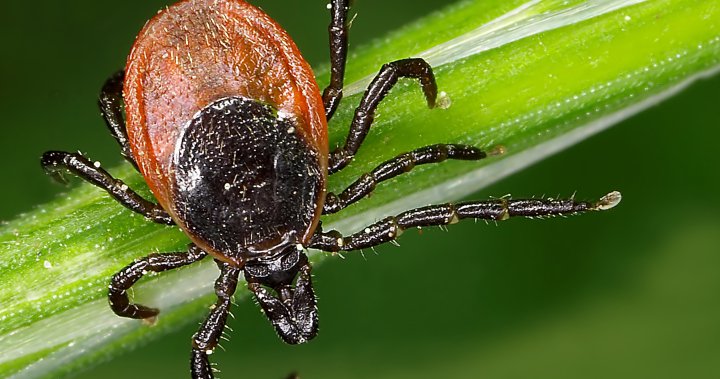As Canadians flock outdoors for hiking, gardening and sunshine this spring, an unwelcome guest is making its seasonal return: ticks.
Thanks to warming winters and milder temperatures, ticks are thriving in more parts of the country than ever before — bringing a growing risk of tick-borne illnesses like Lyme disease.
Black-legged ticks, the species responsible for most Lyme disease cases in Canada, are expanding their range rapidly and are now found in parts of every southern province. This spread is closely tied to climate change, which allows ticks to survive winter and move into once-too-cold regions, putting more people and pets at risk.
Although there are more than 40 tick species in Canada, the most common one is the black-legged tick, also known as the deer tick, and its numbers are on the rise. These ticks become active once temperatures hit 4 C, and they’ll start looking for a blood meal from animals — or humans.
“The black-legged tick and the western black-legged tick out in the West carry Lyme disease and other diseases. So when we’re bitten by ticks, we’re at risk of acquiring these diseases,” said Dr. Sarah Keating with the Canadian Lyme Disease Foundation.
This is because ticks are really good at spreading disease, she said. They have their own microbiome, just like we do, full of various microorganisms.
When a tick starts feeding, some of these organisms can move into its salivary glands. Then, as the tick injects saliva into our skin to keep the blood flowing and avoid detection, those pathogens can enter our bloodstream and potentially cause disease.
Milder winters mean more ticks can survive winter under leaf litter, Keating said.
“In the past, when we had very cold winters, ticks would come on migratory birds. But now they are surviving, and it’s becoming much more, particularly in certain areas of Canada … Nova Scotia, southern Quebec, southern Ontario, and southern Manitoba and southern B.C.”
And the numbers back that up.
Lyme disease is on the rise in Canada. In 2009, there were just 144 reported cases across the country, according to data from the Public Health Agency of Canada (PHAC). By 2021, that number had jumped to more than 2,800.

Get weekly health news
Receive the latest medical news and health information delivered to you every Sunday.
That spike lines up with the growing range of black-legged ticks, which are now found in parts of every southern province. Warmer weather and shifting ecosystems are helping these ticks spread north at a rate of 35 to 55 kilometres each year, studies suggest.
While Lyme disease is the most well-known tick-borne illness in Canada, it’s far from the only one. As black-legged ticks expand their territory, so does the range of diseases they can carry — and scientists are discovering new threats all the time.
“Babesiosis is a big one,” Keating said. “There are also illnesses like ehrlichiosis, anaplasmosis and Rocky Mountain spotted fever. New pathogens are being discovered all the time.”
These lesser-known infections can sometimes be serious, especially for people with weakened immune systems.
Lyme disease is caused by the Borrelia burgdorferi bacterium, which ticks can transmit to humans through a bite. It’s treatable, but early detection is key.
“If someone knows they’ve been bitten by a tick and they develop a rash or flu-like symptoms shortly after, antibiotics can usually clear it up,” Keating said. “The problem is, many people don’t even know they’ve been bitten. The ticks can be tiny and bite you somewhere you don’t see — like your scalp or back.”
Symptoms of Lyme disease often appear in stages. In the early phase, people might notice a bull’s-eye rash around the bite, fatigue, fever or muscle aches. If untreated, the infection can progress to more serious complications.
“After a few weeks, the nervous system can become involved — you might see facial paralysis like Bell’s palsy, joint pain and ongoing fatigue,” she said. “If it becomes chronic, it can even affect the brain and lead to mental health challenges like depression or, in rare cases, psychosis.”
As ticks become more common across Canada, experts stress the importance of doing regular tick checks, especially after spending time outdoors in grassy, wooded or brushy areas.
“It’s very important when people have been outside, especially in the forest or in long grasses, to do a tick check when they come back inside … a complete body tick check, including the scalp, and also to check young children who can’t check themselves,” Keating said.
But ticks aren’t just a problem in the woods; they can also be found in urban areas, including city parks and backyards, explained Justin Wood, CEO of Geneticks, a Canadian company that tests ticks for Lyme disease.
“What I always tell people is that anywhere that birds can go, ticks can go as well,” he said. “Ticks often attach to birds and that’s how they kind of move around locally and across the country, even across the continent.”
Wood also stressed the importance of doing a thorough tick check after spending time outdoors. While adult ticks are easier to spot — about the size of a blueberry when fully engorged — nymphs can be much harder to see, sometimes no bigger than a freckle.
If you do find a tick, he said, the first thing to do is safely remove it. This can be done by using fine-tipped tweezers to grasp the tick as close to the skin as possible, then pulling upward.
“As soon as the tick is off, you can start making decisions about what to do next. Our suggestion is always to test the ticks,” Wood said.
“We don’t have great diagnostics in the early stages of Lyme disease, so if you’ve been bitten, it can be very difficult to tell in the earlier stages if there’s been transmission of disease. Testing ticks can help people make more informed decisions with the help of their health-care practitioner about what the best next steps are.”
Besides doing tick checks, there are other effective ways to help prevent tick bites. Wearing long sleeves and pants, using insect repellent with DEET or icaridin and sticking to the centre of trails can all reduce your risk, he said.
Pets, especially dogs, can be a major pathway for ticks to enter your home, even if they’re not showing any signs of a bite.
“There are preventative medications that can either be taken once a month or once every three months that prevent ticks in dogs,” Keating said. “If a tick bites the animal, it’ll drop off immediately.”
Still, she warned that ticks can hitch a ride in a dog’s fur and make their way into your home, even if they don’t bite your pet.
“If they’re sitting on your lap or sleeping on your bed, the ticks can then crawl onto the humans,” she said. “That is a significant risk for pet owners.”
Doing tick checks on pets, especially after walks or time outside, is just as important as checking yourself. But it’s not always easy.
“I have a big black dog,” Keating added, “and it’s difficult to find ticks on him.”
She encouraged pet owners to talk to their veterinarians about tick prevention and medication available.








